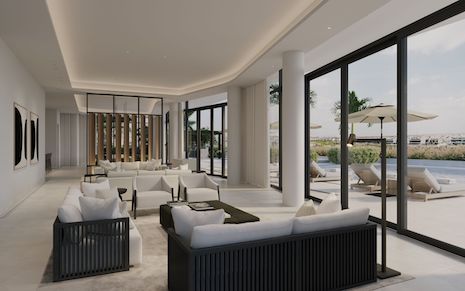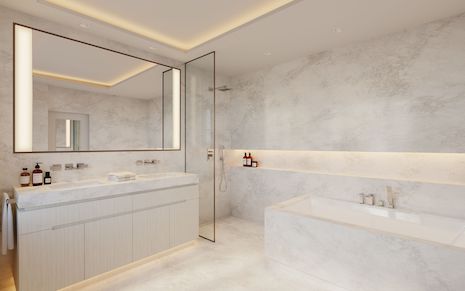- About
- Subscribe Now
- New York,
May 13, 2020

 Minimalist family room designed by Alix Lawson. Image courtesy of Alix Lawson
Minimalist family room designed by Alix Lawson. Image courtesy of Alix Lawson
By Jon Sharpe
Does owning more really make us happier?
After decades of acquisition and maximalism, the 21st century has taught many of us that less really is more. Many of us grew up in a world of manic consumerism and while owning more stuff makes some people happy, there has been a definite shift towards minimalism in order to relieve stress and pressure.
Post-second world war architecture introduced the concept of modernist styles.
A major figure of the time, Ludwig Mies van der Rohe, a German-American architect was the last director of Bauhaus, an architectural style that came to define the era. His 20th-century designs are marked by simplicity and clarity, using minimal structural orders that allowed lots of open space.
Famous for his use of “less is more,” Mies van der Rohe moved to the United States just before the war in 1937 and pushed towards his goal for a new kind of architectural design.
Above all, Mies van der Rohe wanted to create open spaces that feel free within a minimal structure. And this is the core of minimalism – designs that allow us to breathe and to feel less oppressed by the demands of the world around us.
 Minimalist living room designed by Alix Lawson. Image courtesy of Alix Lawson
Minimalist living room designed by Alix Lawson. Image courtesy of Alix Lawson
Conscious minimalism across all design spheres
Minimalism rejects the lessons we have absorbed since birth that we must surround ourselves with endless possessions.
Decluttering hit the mainstream with Netflix sensation Marie Kondo, and there are now movements and social media groups explaining a concept that many of us know to be true – that lots of our possessions fail to “spark joy” and perhaps we do not need them at all.
This conscious minimalism – a purposeful decision to rid ourselves of extraneous clutter – drives architecture and design across many areas of our lives.
From paring down our wardrobes to interior design choices, consciously deciding on minimalism to free our senses from pressure is increasingly popular just about everywhere.
London-based interior designer Alix Lawson exemplifies conscious minimalist designs.
Following 15 years running industry-leading interiors and architecture firm Lawson Robb, Ms. Lawson decided to turn back towards her passion for minimalism. This fueled her decision to launch her own interiors lifestyle brand in 2018.
Ms. Lawson calls her designs “conscious minimalism,” offering as they do a direct antidote to maximalist clutter.
For her, luxury is simplicity, and her entire aesthetic can be seen in her renovations as part of Project Dubai Hills in the Middle East.
“I’ve always been a minimalist at heart and believe that there is so much consideration within beautiful simplicity,” Ms. Lawson said.
This simplicity is reflected in the choice of lighting and material that showcase clean lines against a blank canvas. There is no room for mistakes within conscious minimalist design, as a cohesive, flowing whole is essential for the effect.
 Serenity reigns in this minimalist bathroom by Alix Lawson. Image courtesy of Alix Lawson
Serenity reigns in this minimalist bathroom by Alix Lawson. Image courtesy of Alix Lawson
Conscious minimalism in action at Project Dubai Hills
Project Dubai Hills was one of her new boutique’s first project and gave Ms. Lawson the opportunity to depart from the usual designs seen in the Middle East towards clean minimalist interiors.
Much of the artworks, furniture and design choices have a sculptural feel, and combining bold black lines with clean whites gives the entire space a calm strength.
Another high-profile example of this merging of calmness, light, space and sculpture can be seen in Kanye and Kim Kardashian West’s Los Angeles home.
Over seven years, the Wests worked with international design superstars including Belgian tastemaker Axel Vervoordt to completely transform a standard Los Angeles mansion into a consciously minimalist haven from the chaos of their external world.
Mr. West’s decision to employ Mr. Vervoordt hinged on a single piece of furniture design – a floating stone table. The rounded edges and simplicity of the piece was exactly what the rapper wanted in his home.
Mr. Vervoordt said that their mutual “search for cosmic values of peace and positive energy” powered the initially unlikely partnership to create something truly revolutionary within the world of design and space.
Using proportions as decoration, the total transformation of the interior and exterior architectural design of the mansion is the perfect rendering of conscious minimalism.
Furniture is few and far between, and the color palette is resolutely neutral. Other designers who contributed to the house include minimalist architect Claudio Silvestrin and Vincent Van Duysen helped to provide furniture.
The Wests’ house showcases conscious minimalism in its purist form.
According to Mr. Vervoordt, it was designed around a philosophy: “We changed the house by purifying it, and we kept making it purer and purer.”
Philosophy of conscious minimalism
Minimalism makes you more productive, happier and less stressed.
By switching focus to what you need versus what is unnecessary, emotions can be more easily controlled. This leads to more conscious buying choices.
When furnishing or designing an interior space, choosing only what lends itself to tranquillity means higher quality, fewer pieces and a heightened awareness of what your interior space does to your mind.
Truly embracing conscious minimalism in your interior design includes an entire shift of mindset towards minimalist living. It is more than decluttering and having less furniture – it is about being mindful about your choices.
By incorporating this mindset into furniture, design, color and soft fabric decisions, you can create a home that is a true haven. Being intentional about your choices will carry over into other aspects of your life.
SIMPLICITY IN FUNCTION and form, neutral colors, clean open spaces filled with light and consciously chosen materials come together to form a design trend that is about much more than its aesthetic.
Minimalism has never been a passing fad or a simple design trend – it is a philosophy and a way of life. And it could be just what we need in these most challenging of times.
 Jon Sharpe is chief creative officer of LuxDeco
Jon Sharpe is chief creative officer of LuxDeco
Jon Sharpe is chief creative officer of LuxDeco, London. Reach him at jon.sharpe@luxdeco.com.
Share your thoughts. Click here